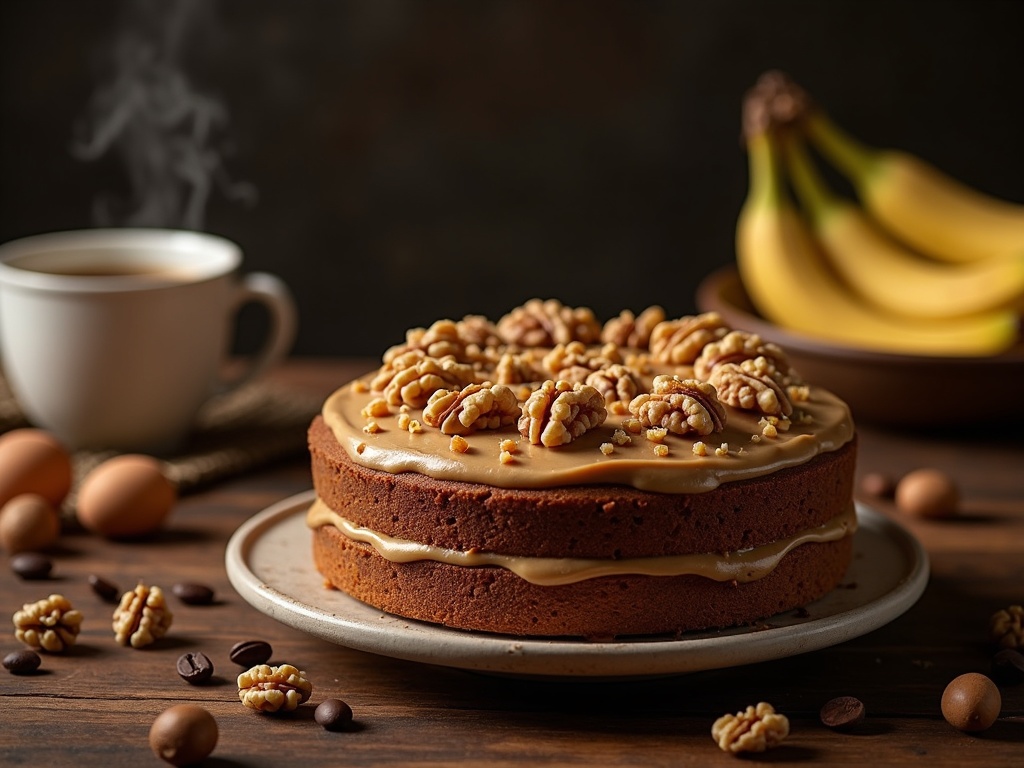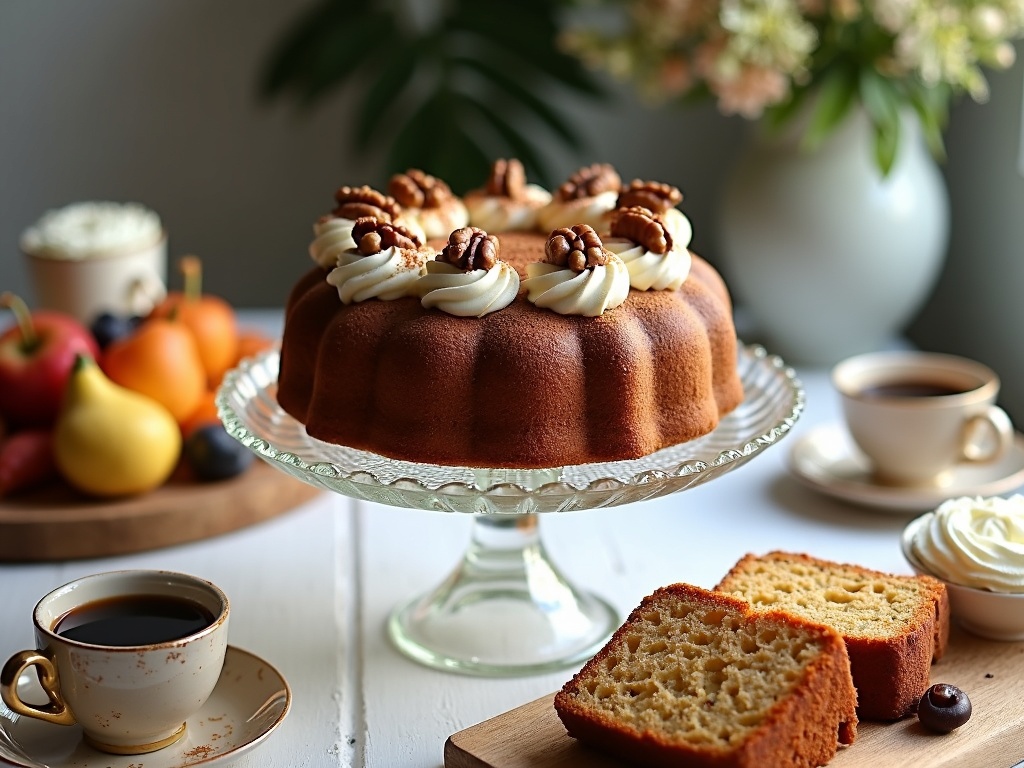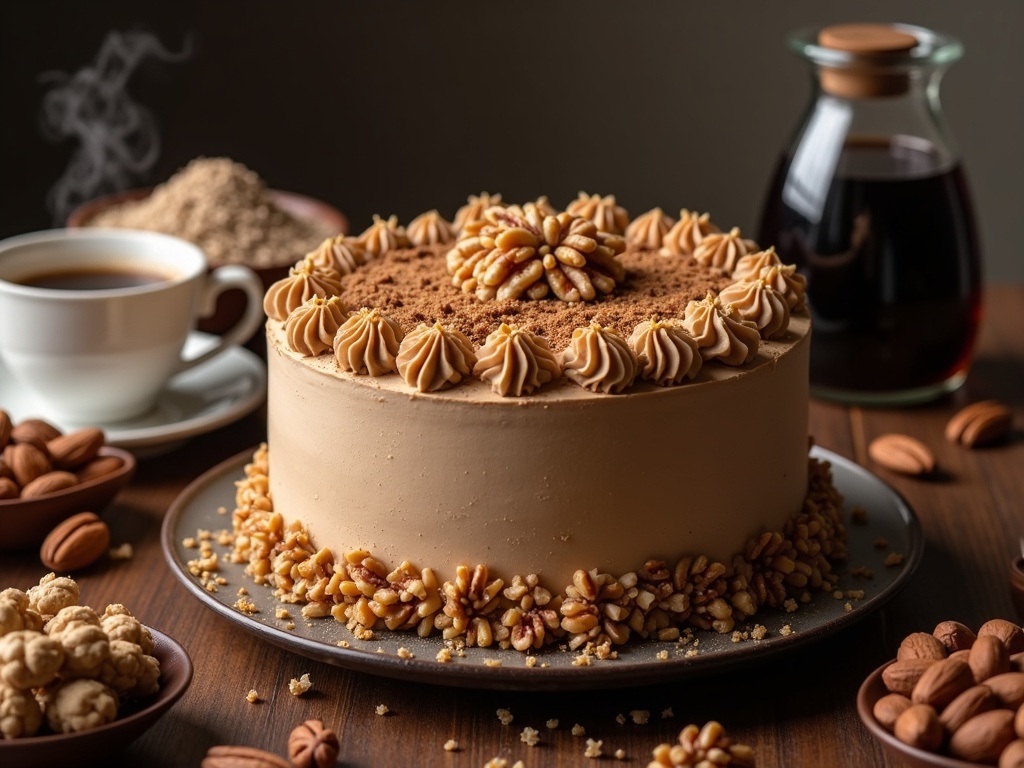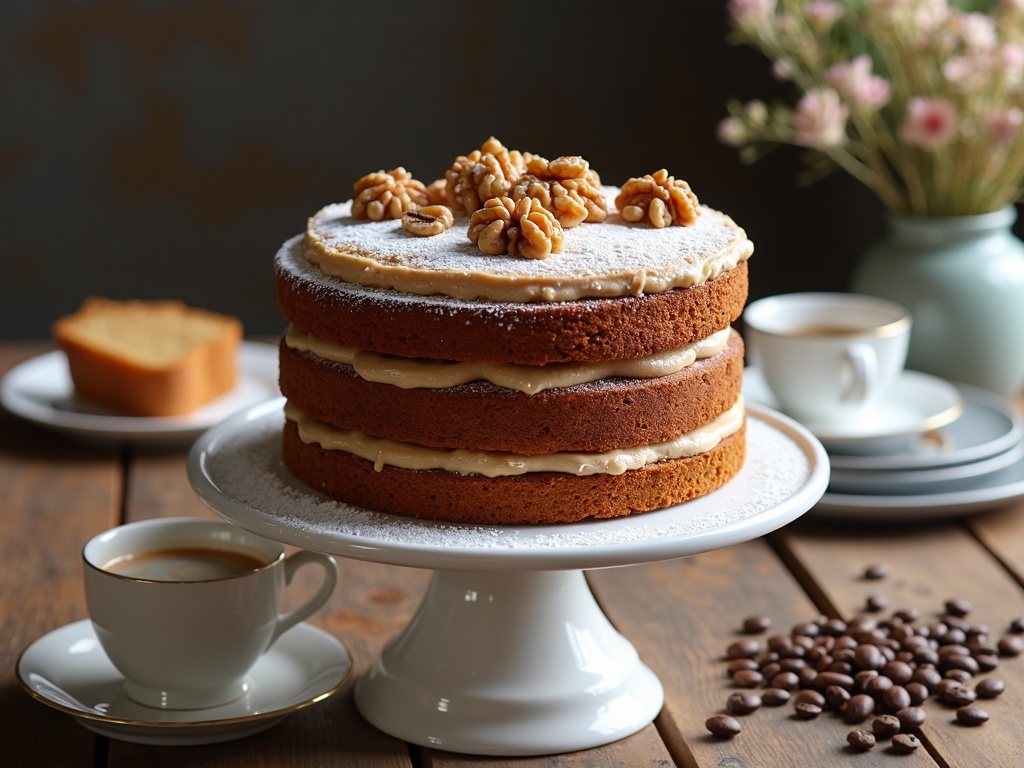Coffee and walnut cake blends global favorites perfectly, mixing coffee’s richness—enjoyed in 2.25 billion cups daily worldwide—with walnuts’ earthy crunch in a classic British dessert that remains popular across generations. This timeless dessert succeeds because coffee’s bitter notes balance the sweet cake base, while walnuts add texture and earthiness, creating an irresistible flavor combination.
Find In This Article
Key Takeaways
- The traditional version features coffee-infused sponge layers with chopped walnuts in the batter, separated by coffee buttercream frosting.
- Walnuts provide essential Omega-3 fatty acids that support heart and brain health, adding nutritional value to this indulgent treat.
- Using espresso rather than instant coffee creates a more authentic flavor, while toasting walnuts before adding them enhances their natural oils.
- The cake has evolved to include modern variations such as vegan, gluten-free, and chocolate-infused adaptations while maintaining its core identity.
- For the perfect texture, avoid overmixing the batter, use fresh walnuts, and allow the cake to cool completely before applying frosting.
The World’s Most Popular Flavors Combined
I’ve always been fascinated by how coffee and walnut cake brings together two of the world’s most beloved flavors. This classic combination isn’t just delicious—it represents a perfect marriage of global favorites. Coffee consumption worldwide has reached an astounding 2.25 billion cups daily, showing just how much people adore this energizing beverage. Finland tops the charts as the most coffee-obsessed nation, with residents consuming approximately 12 kg per capita annually.
The magic happens when coffee meets walnuts in this traditional British dessert. It’s a cake that’s stood the test of time, remaining popular across generations while other dessert trends come and go. I find that the rich, nutty flavor profile combined with the cake’s moist, layered structure creates an eating experience that’s hard to beat.
What Makes This Cake Special
The coffee and walnut cake has earned its place as one of the most popular desserts for good reason. The bitter notes of coffee perfectly balance the sweet, buttery cake base, while walnuts add texture and a wonderful earthy dimension that complements the coffee beautifully.
What sets a great banana loaf recipe apart from a coffee and walnut cake is the distinct flavor profile and structural differences. While banana loaf offers fruity sweetness in a dense loaf format, coffee and walnut cake delivers a more sophisticated flavor combination in a layered structure.
The traditional version features coffee-infused sponge layers separated by coffee buttercream, with chopped walnuts folded into the batter for that signature crunch. Many bakers top their creation with walnut halves, creating a simple yet elegant decoration that hints at what’s inside.
This cake shares DNA with other British classics like Madeira cake in terms of technique, though the flavor profile stands completely on its own. For those looking to experiment with seasonal variations, elements from a plum cake can be incorporated for added dimension.
During the holiday season, some bakers adapt elements from a traditional Christmas cake recipe to create festive versions of coffee and walnut cake, incorporating spices that complement both the coffee and walnut flavors.
For those with dietary restrictions, it’s relatively simple to adapt this classic into a vegan cake recipe by substituting plant-based butter and milk alternatives while maintaining that beloved coffee-walnut combination.
The key characteristics that make a standout coffee and walnut cake include:
- Strong coffee flavor that doesn’t overwhelm
- Fresh, crunchy walnuts distributed throughout
- Moist sponge that doesn’t dry out
- Smooth, coffee-infused buttercream
- Balanced sweetness that lets both primary flavors shine
I’ve found that using espresso rather than instant coffee creates a more authentic flavor, though instant works perfectly well for convenience. Similarly, toasting the walnuts briefly before adding them to the batter enhances their natural oils and flavor.
Whether enjoyed with afternoon tea in true British fashion or as a dessert following dinner, coffee and walnut cake continues to charm cake lovers worldwide by combining two globally cherished flavors in perfect harmony.
Health Benefits and Nutrition Facts
Coffee and walnut cake isn’t just a delicious treat—it also comes with some nutritional advantages that might surprise you. I want to share some key health benefits and nutrition facts about this classic cake that you should know before your next baking session.
Nutritional Profile and Health Benefits
Walnuts are the nutritional superstars in this cake, providing essential Omega-3 fatty acids that support both heart and brain health. These beneficial fats help reduce inflammation in the body and may even improve cognitive function. When I’m enjoying a slice of coffee and walnut dessert, I appreciate that I’m getting these valuable nutrients along with my sweet treat.
The anti-inflammatory properties of walnuts make this cake a better choice than many other desserts. Inflammation is linked to numerous chronic conditions, so incorporating anti-inflammatory foods like walnuts into your diet—even in cake form—can be a small step toward better health.
If you’re tracking your nutritional intake, here’s what you can expect from a typical slice of coffee and walnut cake (based on a cake cut into 12 slices):
- 300 calories per slice
- 15g of fat (including those beneficial Omega-3s)
- 37g of carbohydrates
- 4g of protein
- 2g of fiber
These numbers can vary based on your specific recipe and portion size. If you’re looking for alternatives with different nutritional profiles, you might consider trying a vegan cake recipe or a banana loaf recipe which offers its own unique nutritional benefits.
Coffee also brings its own advantages to this cake. It contains antioxidants that can help fight free radicals in the body. The caffeine content in a slice is minimal but might give you a tiny energy boost when enjoyed with afternoon tea.
For those concerned about sugar content, you can adjust most cake recipes to reduce the amount of sugar while still maintaining that delicious coffee and walnut flavor profile. Some bakers substitute part of the sugar with apple sauce or mashed bananas to reduce the overall sugar content while keeping the cake moist.
If you’re serving this cake for a special occasion like the holidays, it makes a great alternative to heavier options like a Christmas cake while still feeling festive and special.
The nutritional value of coffee and walnut cake makes it a reasonable choice when you’re craving something sweet but don’t want to completely ignore your health goals. By understanding what goes into your cake and appreciating its nutritional aspects, you can enjoy each bite without unnecessary guilt.
When compared to other classic cakes like Madeira cake, coffee and walnut cake often contains more protein and healthy fats thanks to the walnut content. This means you might feel satisfied longer after eating a slice, potentially preventing additional snacking later on.

Perfect Your Baking Technique
Getting the coffee and walnut cake just right means paying attention to both ingredients and method. I’ve found that having everything prepared before starting makes the process much smoother.
Essential Preparation Steps
The magic of this classic cake starts with quality ingredients. For the perfect coffee and walnut cake, I gather:
- 225g self-raising flour
- 225g unsalted butter
- 225g caster sugar
- 4 large eggs
- 2 tablespoons instant coffee
- 100g chopped walnuts
- Buttercream frosting ingredients
Taking ingredients out of the refrigerator about 30 minutes before baking makes a huge difference. Room temperature butter and eggs incorporate much better, creating that light, fluffy texture that makes madeira cake and other classic bakes so special.
I start by preheating my oven to 180°C (350°F) to ensure it’s at the perfect temperature when the batter’s ready. Next, I dissolve the coffee in a small amount of hot water and let it cool slightly – this gives the cake that rich coffee flavor without making the batter too runny.
Creaming the butter and sugar until pale and fluffy takes about 3-5 minutes with an electric mixer. This step creates tiny air pockets that help the cake rise evenly. I add eggs one at a time, mixing well between additions to prevent curdling.
The flour needs gentle folding to maintain the air you’ve worked to incorporate. Once combined, I fold in the cooled coffee mixture and about three-quarters of the chopped walnuts, saving some for decoration.
Dividing the batter between two lined cake tins ensures even baking. The cake needs 25-30 minutes in the oven – it’s ready when it springs back when lightly pressed and a skewer comes out clean.
For the perfect finish, I let the cakes cool completely before adding buttercream. This desserts classic pairs beautifully with a coffee-flavored frosting and a sprinkle of the reserved walnuts.
The total prep time is about 20 minutes, with another 25-30 minutes for baking, making it faster than more complex options like a Christmas cake recipe but just as impressive.
For those looking for alternatives, this recipe adapts well to become a vegan cake recipe by substituting plant-based butter and egg replacers. The technique remains largely the same, though you might need to adjust baking times slightly.
If you enjoy this classic, you might also like trying a banana loaf recipe or a seasonal plum cake using similar techniques.
Serving and Presentation Ideas
Coffee and walnut cake deserves to be showcased in a way that enhances its rich flavors and textures. I’ve found that thoughtful presentation can elevate this classic treat from delicious to truly memorable. Let me share some practical ways to serve and present your coffee and walnut creation that will impress your guests without requiring professional patisserie skills.
Perfect Pairings
The robust flavors of coffee and walnut cake harmonize beautifully with carefully selected beverages. These pairings can complement or contrast with the cake’s flavor profile:
- Fresh espresso or americano: The obvious choice that intensifies the coffee notes in the cake
- Creamy latte or cappuccino: Adds a silky counterpoint to the textured walnuts
- Earl Grey or English Breakfast tea: Offers a pleasant tannic balance to the sweetness
- Dessert wine like Moscato: Creates a luxurious experience for special occasions
For an afternoon gathering, I like to serve slices of madeira cake alongside my coffee and walnut creation for guests who might prefer something less rich. The contrast makes for an interesting tasting experience.
Garnishes and Decorative Elements
The finishing touches on your coffee and walnut cake can transform it from homemade to high-end. I’ve experimented with several garnishing techniques that add visual appeal without overshadowing the cake’s natural beauty:
A dollop of lightly whipped cream or crème fraîche on the side adds creaminess that cuts through the richness. For special occasions, try piping small rosettes of coffee-flavored whipped cream along the edge of each slice.
Dusting techniques create simple yet effective visual impact. Try sifting a light layer of cocoa powder or powdered sugar over the top using a paper stencil for an elegant pattern. Coffee beans placed strategically on top serve as both garnish and a hint of what flavors await inside.
When I’m feeling particularly creative, I toast extra walnut halves and dip them halfway in dark chocolate before arranging them on top of the cake. This adds both texture and a touch of gloss to your desserts presentation.
For layer cakes, I find that applying a thin coffee glaze between layers not only adds moisture but creates an appealing drip effect down the sides. This works particularly well for vegan cake recipe alternatives that might need extra moisture.
The cake stand you choose also impacts presentation significantly. A simple white ceramic stand lets the cake be the star, while a vintage glass pedestal adds charm to afternoon tea settings. For casual gatherings, wooden boards create a rustic, approachable feel.
During the holiday season, I sometimes adapt this classic by adding warming spices to create a variation on Christmas cake recipe traditions – the coffee and walnut flavors work surprisingly well with cinnamon and nutmeg.
For brunch settings, consider cutting the cake into smaller portions and serving alongside fruit platters. The sweet-savory notes of a banana loaf recipe make another excellent companion to coffee and walnut cake when serving a variety of treats.
For dinner parties, individual slices presented on small dessert plates with a fork positioned neatly alongside creates an elegant final course. A simple sauce drizzled on the plate—perhaps caramel or chocolate—adds restaurant-quality flair without much effort.
With these serving suggestions and presentation tips, your coffee and walnut cake will not just taste impressive but look the part too. The versatility of this classic treat means it works for everything from casual coffee mornings to sophisticated dinner parties.

British Heritage and Modern Adaptations
Coffee and walnut cake has secured its place as a beloved classic in British baking tradition since the early 20th century. I’ve found that this delightful combination emerged during a time when coffee was becoming increasingly popular in British households. The marriage of aromatic coffee with crunchy walnuts created a sophisticated flavor profile that quickly became a staple at afternoon teas across the United Kingdom.
What makes this cake special is how it’s evolved while maintaining its core identity. The basic recipe has remained largely unchanged – a moist sponge infused with coffee, studded with walnuts, and topped with coffee-flavored buttercream. This simplicity is part of its enduring charm.
Evolution in Modern Coffee Culture
Coffee and walnut cake has experienced a revival in recent years, finding new audiences in specialty coffee shops and artisanal bakeries. I’ve noticed how it’s become a perfect companion to the third-wave coffee movement, where the cake’s coffee notes can be matched with similar flavor profiles in specialty brews.
Today’s bakers have embraced this classic while introducing creative adaptations. Here are some popular variations that have emerged:
- Vegan versions that substitute dairy butter with plant-based alternatives and eggs with flax seeds or applesauce, creating a vegan cake recipe that retains the original’s moist texture.
- Gluten-free adaptations using alternative flour blends that maintain the cake’s structure while making it accessible to those with dietary restrictions.
- Chocolate-infused variations featuring dark chocolate drizzle or chunks that add depth to the classic flavor profile.
- Seasonal twists that incorporate spices similar to those found in a Christmas cake recipe, creating festive versions for holiday gatherings.
One notable modern adaptation is the shift from instant coffee to freshly brewed espresso or cold brew concentrate. This change aligns with contemporary coffee connoisseurship and can result in a more complex flavor profile. The intensity of fresh coffee brings out the nuttiness of the walnuts in a way that instant versions sometimes miss.
The cake’s structure shares similarities with other British classics like banana loaf and Madeira cake, featuring a dense yet tender crumb that holds up well to the inclusion of walnuts. Some bakers have even combined elements from plum cake traditions, incorporating dried fruits for added texture.
Coffee and walnut cake exemplifies how traditional recipes can remain relevant through thoughtful adaptation. Its journey from tea rooms to trendy cafés shows how classic desserts can bridge generations while speaking to contemporary tastes.
I’ve seen home bakers experiment with different coffee varieties – from light to dark roasts – each bringing unique characteristics to the final product. Some use specialty single-origin coffees to impart fruity or chocolatey notes that complement the walnuts in unexpected ways.
What fascinates me most about this cake’s evolution is how it maintains its cultural significance while accommodating modern dietary preferences and flavor trends. It’s a testament to good design – simple enough to allow for personalization but distinctive enough to remain recognizable through its many iterations.
Expert Tips and Customization
I’ve made countless coffee and walnut cakes over the years, and I’ve picked up several tricks to elevate this classic treat. The beauty of this cake lies in its versatility – you can easily adapt it to suit different tastes and dietary needs.
Nut Variations and Adjustments
While walnuts provide the traditional crunch and nutty flavor, I often experiment with other nuts for different texture profiles. Pecans offer a buttery, more delicate crunch compared to walnuts, making them an excellent substitute or addition. Almonds, whether sliced, flaked, or chopped, bring a sweeter, milder flavor that complements the coffee beautifully.
When it comes to the amount of nuts, I’ve found it’s entirely personal preference. For a more subtle texture, I’ll use about 80g of chopped nuts, but for true nut lovers, up to 150g works wonderfully in a standard recipe. I’ve even created a banana loaf recipe using the same nut adjustment principles with great success.
Common Pitfalls to Avoid
I’ve learned through many baking sessions that these mistakes can derail your coffee and walnut cake:
- Overmixing the batter – this develops too much gluten, resulting in a tough cake
- Using old or rancid walnuts – always taste test before adding
- Adding too much coffee extract – start with less and adjust to taste
- Opening the oven door too early – causes the cake to sink
- Applying frosting while the cake is still warm – creates a melty mess
The pandemic sparked significant interest in dietary-specific baking, and I’ve adapted my coffee and walnut cake accordingly. Gluten-free versions work surprisingly well with a good quality 1:1 flour substitute, while vegan cake recipes can use plant-based butter and flax eggs.
For those looking to reduce sugar, I’ve had success replacing up to half the sugar with erythritol or stevia. Coffee lovers might enjoy a stronger brew in the batter, which pairs wonderfully with the nuts. I sometimes add a splash of almond extract alongside the coffee for added depth.
For special occasions, I transform this humble classic into something spectacular by layering it like a Christmas cake recipe with extra frosting between each tier. The combination of rich coffee, crunchy walnuts, and creamy frosting creates a dessert that rivals fancy patisserie offerings but with homemade charm.

Sources:
National Coffee Association – Coffee, Tea, and Health
Healthline – Nutrition Guide: Coffee & Walnut Cake
BBC Good Food – The History of Coffee Cake
The Kitchn – Baking Tips for Success
Statista – Global Coffee Consumption Trends

